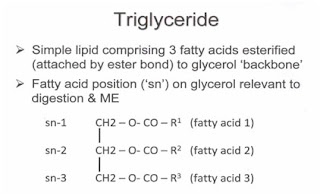•
FAT is another
name for Lipids, Lipids of importance are triglycerides, phospholipids, sterols
and fat-soluble vitamins (Brindley,1984)1
•
Types of Lipids?
(a)
Simple lipids which are esters of fatty acids with various alcohols.
They are of two types namely; Fats and oils-which are esters of
fatty acids with glycerol and the other group is Waxes
(present in Rice bran oil, soybean oil and others) which are esters of fatty
acids with high molecular weight monohydric alcohols not recommended for
poultry and most suited for Cosmetic industry.
(b)
Compound
Lipids: examples are Phospholipids,
glycolipids and lipoprotein) Phospholipids are fats containing phosphoric acid
and frequently have nitrogen containing bases and other substituents. Glycolipids
are fats containing carbohydrates and lipoproteins are lipids bound to
proteins.
(c)
Derived Lipids: examples are fatty acids, glycerol, alcohols, fat soluble
vitamins, sterols and terpernoids. These are derived by hydrolysis from simple
or compound lipids. Most abundant sterol in animals is cholesterol
•
OILS are LIQUID
(Vegetable oils) whereas FATS (Tallow, Lards, Butter, Ghee etc.) are solids at
room temperature. Naturally LIPIDS are, insoluble in
water.
•
Technically they
are TRIGLYCERIDES or TRIACYLGLYCEROLS with different fatty acid profiles. OILS are esters of glycerol just like FATS (Tisch,2006)
•
Triglycerides
contain three fatty acid molecules esterified to the three hydroxyl groups of
glycerol.
•
Simple
triglycerides contain only one type of fatty acid, whereas mixed triglycerides
have two or three types (Enser, 1984). Fatty acid is an organic acid with a hydrocarbon chain
connecting with a carboxyl group. If the same fatty acid occupies all three
binding sites (Sn1, Sn2 & Sn3) on the positions of glycerol molecule, the
compound is termed a simple triglyceride. If for example, stearic acid is
conjugated at all three positions, the compound is called tristearin and if
different fatty acids occupy three positions, then the compound is termed as
mixed glycerides (Tisch,2006)
•
Free fatty
acids (FFA) are free floating acids
not attached to any other organic component, like glycerol.
•
The term
“saturated” indicates the absence of double bonds and this term is used with
respect to hydrogen atoms, whereas “unsaturated” is the presence of one or more
double bonds and is “unsaturated” in terms of hydrogen.
•
Presence of a
double bond decreases the melting point (OILS)

Longer the chain, Lesser
the double bonds, LESS soluble the fat will be in water(TALLOW) as their
melting point is also higher.
Composition of fatty acids,
degree of saturation and length of the carbonic Chain, determines fat quality.
FATTY ACIDS AND THEIR
TYPES: (Tisch,2006)
1.
Short chain
fatty acids (SCFA)-has aliphatic tails
of less than six carbons such as C4:0(Butyric acid);C6:0(Caproic acid)
2.
Medium Chain
Fatty acids (MCFA)-has
aliphatic tails of six to twelve carbons such as C8:0 (Caprylic acid); C10:0
(Capric acid); C12:0 (Lauric acid); C14:0 (Myristic acid)
3.
Long Chain
Fatty acids (LCFA)-has aliphatic tails
between 14 to 20 carbons such as C15:0(Pentadecanoic acid); C16:0 (Palmitic
acid); C16:1 (Palmitoleic acid); C17:0 (Margaric acid); C18:0 (Stearic acid);
C18:1 (Oleic acid); C18:2 (Linoleic acid); C18:3 (Linolenic acid); C20:0
(Arachidic acid); C20:4 (Arachidonic acid); C22:0 (Erucic acid); C22:5
(Clupanodonic acid)
4.
Very Long Chain
Fatty acids (VLCFA)- has
aliphatic tails of more than 22 carbons such as C24:0 (tetracosanoic acid)
*Suffix 0 indicates no
double bond and Suffix 1-5 indicate number of double bonds.
*The most abundantly
available fatty acids are the ones between C14 to C22.
*Fatty acids with odd
numbers such as C15, C17 are more commonly found in microorganisms
(Source: Pond et.al.(2005)
2
•
Further classification of
unsaturated fatty acids is done on the basis of arrangement of hydrogen atoms; namely,
(Bettelheim et.al.2009, Mcdonald
et.al.2002)
1.
TRANS FATTY
ACIDS- Unsaturated fatty acids with hydrogen
atoms on the opposite of double bond- these are not found in nature and formed
after a process called hydrogenation
2.
CIS-FATTY
ACIDS- Unsaturated Fatty acids have
hydrogen atoms on the same side of double bond. They are naturally occurring
with most unsaturated fatty acids.
References: -
1.
Brindley,
D.N.(1984), Digestion, Absorption and Transport of Fat: general principles In
Wiseman, J (Ed), Fats in Animal Nutrition,(pp85-103), Butterworths,
London,UK.,
2.
Pond W.G.,
Church,D.C.,Pond K.R.,and Schoknecht,P.A.(2005), Basic Animal Nutrition and
Feeding (5th ed.)John Wiley & Sons Inc.USA.
3.
Tisch,D.A.(2006)
Animal Feeds, feeding and nutrition, and ration evaluation, USA)
4.
Mcdonald,P.E.;Edmonds,
R.A., Greenhalgh J.F.D., and Morgan,C.A.(2002), Animal Nutrition 6th
ed.
5.
Piyamas
Tancharoenrat, 2012, A thesis presented for Doctor of philosophy in poultry
nutrition at Massey Universit, Palmerston North, New Zealand, Factors
influencing fat digestion in Poultry.
6.
Enser,
M.(1984).The chemistry, biochemistry and nutritional importance of animal fats,
in Wiseman,J,(Ed.), Fats in Animal Nutrition) Butterworths,
London UK.





No comments:
Post a Comment